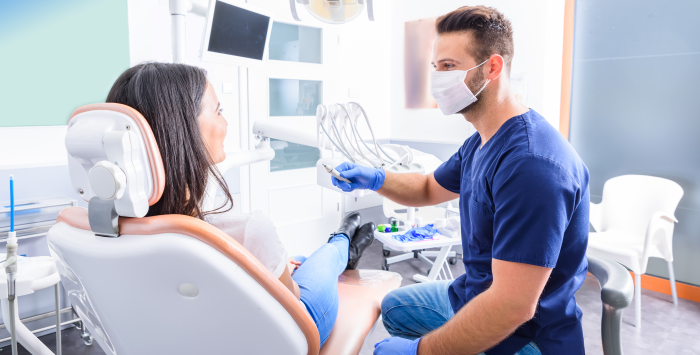Dental insurance for adults

Here’s what you need to know when you’re shopping for adult dental coverage through the marketplace or directly from a dental plan carrier.

Adult dental insurance in the United States
Most American adults who have dental insurance obtain it from an employer. Nearly all large employers offer dental coverage, and the majority of those employers pay a portion of the premiums, making it easier for employees to afford to enroll in the coverage.
How can I buy adult dental insurance?
If your household income is fairly low and you’re in a state that provides adult dental coverage as part of its Medicaid program, you may find that Medicaid dental provides all the coverage you need. (Learn more about Medicaid dental).
But if you’re not eligible for Medicaid or an employer’s dental plan, you’re going to need to purchase your own dental plan in the private market – assuming you’re sure you need dental insurance, which is not always the case.
There are basically two options for obtaining your own dental coverage: You can buy a plan through the exchange/marketplace in your state, or you can buy a plan directly from a company that offers dental coverage for individuals in your area.
Explore your dental insurance options.
Need dental coverage? Shop and enroll in coverage that can start as early as tomorrow.



Issues to keep in mind when selecting adult dental coverage
There are a few things to keep in mind when you’re sorting through the options:
- Adult dental coverage is not regulated by the ACA. So regardless of whether you buy a dental plan through the marketplace or directly from an insurer, the sort of regulations that apply to on-exchange pediatric dental coverage will not apply to an adult dental plan.
- Is your dental plan embedded? It’s possible that some of the medical plans available in your area (on-exchange or off-exchange) might have adult dental coverage embedded in the plan – this varies from one state to another, and generally also varies from one plan to another within a state. If they do, you’ll want to understand how the plan works in terms of out-of-pocket costs, what dental services are covered, and whether the dental expenses count toward the same deductible as medical expenses.
- Where you live affects your options. Depending on where you live, you will likely only be able to buy a dental plan through the exchange if you’re also buying a health plan through the exchange. This is the rule in the 33 states that use HealthCare.gov, although some of the fully state-run exchanges allow people to purchase a dental plan on its own. (Federal legislation has been introduced in 2023 that would allow a person to buy stand-alone dental coverage through the exchange even if they’re not also buying health insurance.)
- Exchange enrollment is limited. You can only buy a dental plan through the exchange during open enrollment or a special enrollment period.
- Stand-alone dental plans that are sold outside the exchange can be purchased at any time. (Note that this differs from health insurance; individual/family major medical plans can only be purchased during open enrollment or a special enrollment period, regardless of whether you shop in the exchange or outside the exchange.)
Dental insurance plan selection considerations
If you’re shopping for adult dental coverage, there are several things you’ll want to consider:

Do you already have an established relationship with a particular dentist, and is it important to you that you continue to be able to see this dentist? If so, you’ll want to check the networks of the available dental plans to see if your dentist is in-network.
(You can check with the dentist directly, to see if there are any plans that they recommend. In lieu of insurance, they may offer a membership that provides you with various dental benefits as long as you use their practice.)


If you’re willing to see any dentist, you’ll have a wider range of options available to you. But it’s still important to make sure that the plan has in-network dentists (and dental specialists, such as periodontists and endodontists) who are conveniently located for you, and who are accepting new patients.


Do you have children who also need dental coverage? If so, this might tip the scales toward purchasing a plan through the exchange, in order to obtain the more robust pediatric dental benefits that are available on those plans.
But again, that might not be an option unless you’re also buying a health plan, and it will only be available at limited times during the year. If you don’t mind having the same limited dental benefits for each member of the family, an off-exchange family dental plan might work just fine.


Do you need dental care (other than preventive care) in the immediate future? If so, pay particular attention to things like waiting periods and benefit caps.

Frequently asked questions about adult dental insurance
How many people purchase stand-alone dental through the exchange?
Stand-alone dental plans are available through the exchange in every state, although the number of plan options varies from one area to another.
During the open enrollment period for 2023 coverage, nearly 2.3 million people enrolled in stand-alone dental plans through the exchanges nationwide. (For comparison, nearly 16.4 million people enrolled in private health plans through the exchange.) And most of the people who enrolled in stand-alone dental plans through the exchanges were adults – only about 209,000 were under the age of 18.
What are the various types of dental insurance?
Dental plans can be indemnity plans or managed care plans.
- Indemnity plans (also known as fee-for-service plans) do not have provider networks and will allow you to see any dentist you like. But the plan will only pay a set amount for each service, and you’re responsible for the rest of the dentist’s bill. These plans are much less common than they used to be, and account for just a small fraction of current dental plans.
- A managed care dental plan can be a PPO (preferred provider organization), HMO (health maintenance organization), EPO (exclusive provider organization), or POS (point of service) plan. Here’s an overview of how those types of managed care work in terms of health insurance. The general ideas are similar for dental plans.
- Dental PPOs are the most common type of plan, dental HMOs are somewhat common, while dental EPOs and dental POS plans are fairly rare. All four types of managed care dental coverage will have a network of dentists you can utilize. Staying within that network will keep your costs as low as possible (and dental HMOs and EPOs generally won’t cover any out-of-network care). Some plans, particularly HMOs, will require you to have a primary care dentist who will need to write a referral in order for specialty dental care to be covered.
How are adult dental plan benefits limited?
Stand-alone adult dental coverage generally has a benefit cap somewhere in the range of $500 to $2,500 per year, although caps of $1,000 to $1,500 tend to be the most common. For most routine dental work, this will generally be plenty. But if you end up needing extensive dental work — such as multiple implants — you may find that your needs exceed the benefit cap.
On any adult dental plan, preventive services (cleanings, exams, x-rays) will typically be fully covered. For basic services, such as fillings, extractions, and root canals, it’s common to see 70% or 80% coverage. And the cost of more substantial services, such as crowns, bridges, and implants, is often split 50/50 between the dental plan and the patient, up to the plan’s benefit caps.
Some adult dental plans will increase your benefit cap over time, or reduce your coinsurance rate over time. For example, you might get a plan that initially has a $1,000 benefit cap, but it grows to $1,250 in the second year and $1,500 in the third year. Or you might find a plan that requires you to pay 50% of the cost of certain services in the first year, 40% in the second year, and only 20% in future years.
If you’re planning to continue to have dental insurance over the long run and you’re happy with the dental network that the plan offers, this type of plan will reward your loyalty with enhanced benefits over time.
Does adult dental coverage have waiting periods?
Most adult dental plans will cover routine preventive care (exams, cleanings, x-rays) in full, as soon as your plan takes effect. But it’s common for adult dental plans to have waiting periods of up to a year before some of the more expensive dental procedures are covered (a typical waiting period structure is six months for basic services and 12 months for major services). However, the insurer may waive the waiting period if you show proof that you had other dental coverage prior to enrolling in the new plan.
Alternatively, some plans might require an initial 12-month commitment (with a monthly payment option available) instead of waiting periods. This would allow you to get coverage for major services right away, but you would not be able to drop the coverage after receiving that care.
What are the differences between buying adult coverage on-exchange versus off-exchange?
If you’re shopping outside the exchange and you have children in your family who will be on the dental plan with you, keep in mind that the ACA’s pediatric dental benefits do not have to be offered on plans that you purchase outside the exchange.
If you’re only buying coverage for adults, the overall benefit options will be fairly comparable on-exchange and off-exchange. But if your plan will also cover children, the benefits that will be provided to the children via an on-exchange dental plan will be much more robust than the benefits that will be provided to adults (this will generally be true even if the children and adults are covered under the same plan; the benefit specifics will be different).
As noted above, dental insurance can only be purchased through the exchange during open enrollment or a special enrollment period. And in the majority of the states, it can only be purchased together with health insurance — which means the exchange might not be a good solution if you only need dental insurance. (Legislation under consideration in 2023 would allow stand-alone dental plans to be purchased via HealthCare.gov by a person who isn’t also buying health insurance.)
For example, maybe you work for an employer that provides medical coverage but not dental coverage. Or maybe you have Medicare and thus cannot buy an individual market plan (Original Medicare does not cover dental services, but Medicare beneficiaries do not need — and cannot buy — health coverage in the marketplace).
Fortunately, there are off-exchange dental plans available nationwide, year-round, without the need for a qualifying event. Depending on where you live, you’ll generally find that different insurers offer plans on-exchange and off-exchange, so it’s worth comparing both options (assuming you’re eligible to purchase a dental plan through the exchange).
What are some examples of stand-alone dental plans available in the marketplace?
As an example, let’s look at the stand-alone dental plans that are available through the exchange (HealthCare.gov) in the Chicago area. There are 24 plans available for 2023, offered by ten different dental insurers. Most are dental PPOs, but there are three dental EPOs and one dental HMO.
- On the inexpensive end of the spectrum, the premiums for a single adult are less than $15/month — but some of those plans only cover basic preventive care (exams, x-rays, and cleanings).
- For plans with mid-range premiums ($22 – $26/month for a single adult), basic and major services are covered, in addition to zero-cost preventive care. Deductibles tend to be well under $100. Some of the plans have benefit caps as low as $800, while others have benefits caps as high as $1,500. Most have waiting periods of up to 12 months before major services are covered.
- The most expensive plans have premiums that range from $37 to $56/month. But these plans still have benefit caps of $1,000 or $1,500, and waiting periods of six months for basic services and 12 months for major services. Depending on the plan and whether the member uses an in-network dentist, it’s common to see 70% to 80% coverage for basic services and 40% to 50% coverage for major services.
If we look at plans in the Chicago area that are available outside the exchange (directly from insurers, or from online brokers that offer plans from numerous insurers), the coverage details tend to be fairly similar, although there are different insurers offering plans. And one plan, offered by UnitedHealthcare/Golden Rule, has a benefit cap of $3,000, which is quite a bit higher than the benefit caps offered on most dental plans.
Is dental insurance worth the cost?
Dental premiums matter …
A self-purchased dental plan for a single adult will tend to cost somewhere between $10 and $70 per month. If a plan has a very low premium, be aware that it might be a dental discount plan, or it might only cover preventive care. As always, you’ll want to read all of the fine print.
On the higher end of the price spectrum, you might have more robust benefit limits, shorter waiting periods, a larger network of dentists, or lower costs when you receive dental services (for example, the plan might have a lower deductible, or pay a larger percentage of the cost of various services).
But don’t assume that you need to buy the most expensive plan in order to have the best benefits. There are price differences from one insurer to another that aren’t related to the quality of the plan. And if you’re happy with the dentists you can use on a plan with a smaller network, you may find that you can save money by choosing that plan, as opposed to a plan with a broader network.
Dental insurance premiums tend to be similar for employer-sponsored coverage, but many employers, particularly large employers, pay a portion of the premiums. When people are purchasing their own adult dental coverage, they have to pay all of the premiums themselves.
… but consider your dental care utilization.
So it’s important to run the numbers, consider your normal dental care utilization, and figure out whether it makes sense to buy a stand-alone dental plan, sign up for a dental membership with your preferred dentist, or just pay full price each time you need dental care.
An injury or illness can cost tens of thousands of dollars to treat, which is why it’s always a good idea to purchase comprehensive medical coverage. But the annual benefit caps on most dental plans mean that they wouldn’t be particularly beneficial if you were to need tens of thousands of dollars worth of dental care. So although it’s almost never a good idea to “self-insure” your medical coverage, self-insuring your dental coverage might make perfect sense, especially if the coverage isn’t being subsidized by an employer.
A person in good dental health who only receives two annual cleanings at $85 each would come out ahead if they self-paid, instead of purchasing a dental plan that costs $360 annually.
Does dental insurance make sense for you?
But dental insurance usually makes financial sense for individuals needing somewhat extensive dental work. The average cost of a root canal can be as high as $2,000, and a crown can cost as much as $3,000. For services like that, a person with a dental plan will likely come out ahead, assuming that they’ve completed any necessary waiting periods before the need for care arises.
But again, the benefit caps mean that most adult dental benefits will be fairly limited in terms of the coverage they’ll provide if a person needs extensive dental work. Multiple dental implants, for example, would not be covered in a single year due to the benefit cap.
Louise Norris is an individual health insurance broker who has been writing about health insurance and health reform since 2006. She has written dozens of opinions and educational pieces about the Affordable Care Act for healthinsurance.org.

